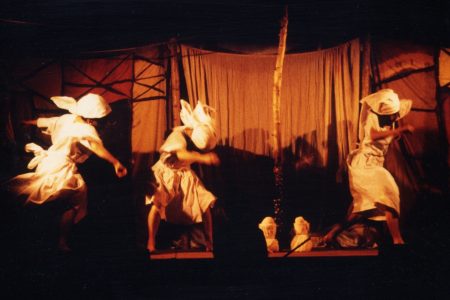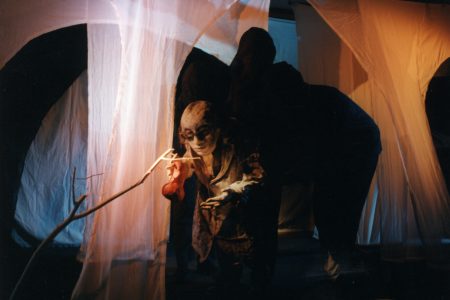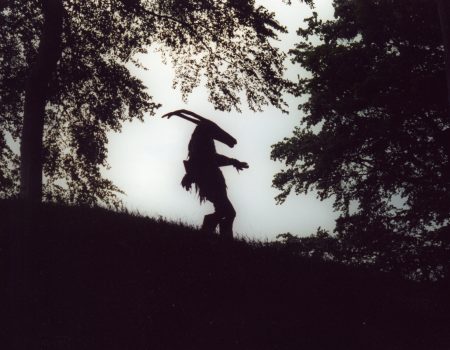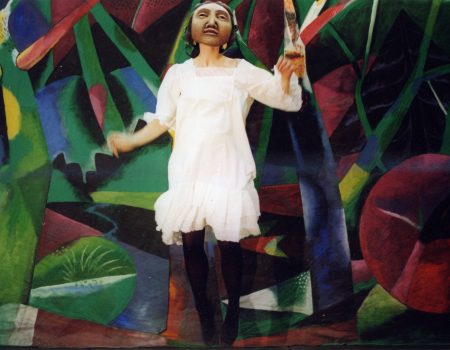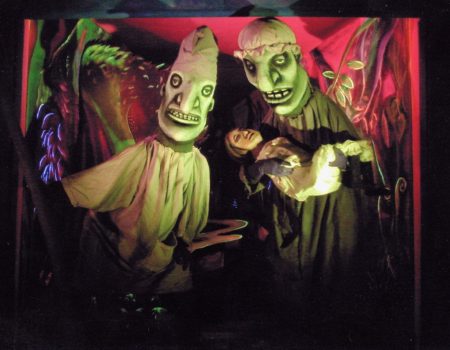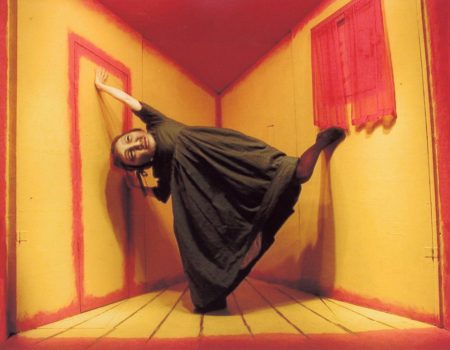1994: Dance of White Darkness
Our next project was to dramatise the story of Maya Deren. Deren is an important figure in the history of alternative cinema in the USA. But what first attracted my attention was her book ‘The Voodoo Gods’ (originally called ‘The Divine Horsemen’). This impressed me when I first read it in the early 1970s. It is the story of Deren’s journey to Haiti, initially to film voudon dance. This venture took her on an unplanned inner journey that resulted in her becoming a mambo, a voudon priestess. The book is also a critique of modern western beliefs and morals, which Deren compares negatively with the integrity and cooperation that she experienced among the serviteurs (sèvitè), the followers of voudon with whom she came to live and work.
I was feeling increasingly confident in what we could achieve on stage. In Dance of White Darkness I dropped any caution. The story attempted to explore voudon ceremonies, the loa spirit world, and spirit possession on stage. The story also looked at the relationship between these things and the ‘tourist voodoo’ that Deren writes about and comments on in her book.
One problem was to find performers who could interpret the material. Not so much the Maya Deren character herself, who was on a journey of discovery as a sophisticated American artist in, initially, an alien world. The real difficulty was finding performers to play the Haitian villagers and sèvitè. They would be the participants in the voudon ceremonies. Despite making an enormous effort I found it impossible to find experienced Afro-Caribbean performers. We contacted the Gambian/Senegalese master drummer Lamin Jassey and his then wife, Vicky. Culturally there are very close links between West Africa and Haitian voudon. Vicky joined the touring company and Lamin and Vicky together worked with us to train the performers in voudon ceremonies and dance. It was a big regret that we couldn’t find any other Haitian, West Indian or African performers at that period. I asked the Chair of our Board, Erik Knudsen, who is half Ghanaian, if he felt that we should abandon the project as a result of this. Erik was adamant that we should continue with our show.
Possession
The title we finally hit on was Dance of White Darkness. It was a phrase used by Maya Deren in attempting to describe spirit possession. This is when a sèvitè is gripped by a trance in which their body is taken over, possessed, by a voudou spirit, or loa. Another key image that I used in our show was taken from the same passage in Deren’s book – that of the horse and rider. The idea here is that the body of the sèvitè becomes the mount for a loa. It was a potentially difficult subject to deal with.
Performing the show at Atlantic College, an international college in South Wales, I was approached be a member of college staff after the show. He introduced me to a young woman, who turned out to be a Haitian student. She asked if we could speak alone. She then asked me ‘how did I know these things?’ She told me that on leaving Haiti her family said that in Wales she should never, ever, talk about her religion. Yet, here we were, an English theatre company, dealing with what she assumed were strongly taboo subjects here. She assumed that I must have lived in Haiti.
The tours
We spent ten weeks in preparation and rehearsal, and a couple more weeks on previews. Then we packed, and the company of nine (and our horses) were ready at the beginning of July. The show toured to Dumfries & Galloway, Cumbria, Lancashire, Yorkshire and Humberside. Later we took the show to the Netherlands. During the 1990s we had a wonderful Dutch agency – Drie Stenen – who produced highly successful, and profitable, tours for several years.
In 1995 we started a second tour of the show in Caithness. After this we travelled south, and eventually hooked up with a ship to Orkney, as part of the St. Magnus Festival. On Orkney we walked to the island of South Ronaldsay.

After Orkney we took the show to Roma settlements in Slovakia. Then, later, to refugee groups on the Hungarian border areas with Croatia and Serbia. Refugees were pouring over the border to escape the war, and we performed in centres where young people affected by the conflict were gathering to meet one another.
It was an extraordinary situation for us. But we felt that we were playing a useful part simply by being there with our show, improvising parades and entertainment for the locals and the young refugees. What we didn’t know at the time was that, caught up in the instability of the conflict zone, a number of promises to pay us for this work were broken. When we returned we found that the tour had left us with a deficit of £11,500. It would be double that amount by today’s standards. Overall not a huge amount, but a big blow to the company at that point in our history.
The company consistently hit upon small details which communicate the changes in Deren better than the sue of spectacular effects would. Only the tourists and their masks are caricatures. Deren and teh Haitians have eloquently sculpted masks which contribute to a sense of realism rather than distract from it. The vodoun apparitions were created in simple but enormously effective ways; never frightening; sometimes stunningly beautiful – the spiritual world of vodoun is made visible.
The music, which was performed live, was integral to the performance. It carried one along and without exaggeration could be said to form the stage for the performers. I can’t think of a better compliment! It is also no exaggeration to say that Horse + Bamboo, by telling Deren’s story in this way, have achieved what she herself failed to do, namely to capture a lifelike impression of Haitian spiritual life.
Maarten Jansen trans. Elke Deadman.
BOB FRITH (wr/dir), LOZ KAYE (m), JILL PENNY, NICKY FEARN, BRIAN PORTER, URSULA BURNS, FRANCES KING, MARY KEITH (m), VICKY JASSEY (m), JO KING, CHRISSY RUCKLEY, ELAINE KINGSTON, NEVILLE CANN (m), GEZ HEBBURN (m), GARETH JENKINSON (LX), DULCIE BEST (set), TC HOWARD (choreography), ELE WOOD (h), LIAM CARROLL (h).
1987: The Legend of the Creaking Floorboard
My recent scripts had been based on the lives of historical figures – Jose Guadalupe Posada, Maya Deren, and Abbess Hildegard of Bingen. I felt like time to invent an entirely new story. An inspiration for the idea was Lol Coxhill’s 1976 recording Diverse. On the first side of the record there’s an improvised piece for soprano saxophone and a loose floorboard. The Legend of the Creaking Floorboard also has obvious references to the tale of Orpheus and Eurydice – Orpheus in the Underworld.
The masks
I also wanted to try working with big, formalised masks worn above the head. The performers look out of a gauze ‘window’ at the neck level of the characters. I used this type of mask in Angel Mummers, so I knew that it would produce a highly stylised performance. It results in the masked figures moving more like a large puppet than an actor or dancer. In contrast, for much of the performance the male figure would be a bunraku-type puppet, operated by three puppeteers. Unlike the large women it was half life-size. Using three puppeteers invests this kind of puppet with an unusual power, as if it funnels three times the energy and presence of a normal puppet.
Gog and Magog
In The Legend of the Creaking Floorboard the two main characters are sisters, Gog and Magog. At the start of the story they sit on their rocking chairs, both calmly knitting. But Gog, it turns out, has a lover, the Knife-grinder. He makes an unplanned visit and invites her out, leaving Magog on her own for the evening. Magog is a clearly a little put-out by this turn of events but she tries to relax. However, as she knits, her rocking chair disturbs a loose floorboard. The creak just gets louder and louder. The noise irritates her, and she tries to fix it by tapping the board gently with a hammer. But nothing works – the creaking gets louder and louder and finally, Magog explodes into a rage. Picking up the hammer she destroys the offending floorboard, smashing it into splinters. Uncontrollable, she turns to the next one and then the next…wood flies everywhere….a huge hole appears in the floor. Only then does Magog stop and gape at the damage she has done.
The Underworld
At that moment Gog and the Knifegrinder return home. Astonished, all three stare into the hole in the middle of what had been their living room. Knifegrinder offers to look under the floor to assess the damage, and he gingerly lets himself down into the hole. When he reappears he asks the two sisters to pass him various tools and items. Each time he disappears below the floor for a few seconds longer. Increasingly fascinated by the underfloor world, he asks for his bicycle to be passed down to him. Gog remonstrates – she is getting nervous, and worries for her friend, but the bicycle gets carefully passed into the underworld. Knifegrinder ties one end of Magog’s knitting wool to his handle-bars. He reassures the sisters that he will keep a connection to the room above. As he cycles off under the stage, we see the wool unwinding on its knitting needle, slowly at first but getting faster and faster – until it come to its end and flies off into the hole. The loose end promptly disappears below the floorboards, leaving Gog and Magog stranded and horrified at the turn of events.
At this point in the story there’s a big change. The stage is invaded by a group of sweeping women – all with the same high head masks as Gog and Magog themselves. They sweep the stage, then totally transform it into a cavernous underworld. The story then continues with Gog’s search for Knifegrinder in the Underworld. This, possibly the strangest of all Horse + Bamboo shows, was well received and toured for two years in the UK and the Netherlands. This was almost the last of our horse-drawn tours, although that honour really goes to ‘The Girl Who Cut Flowers’ which toured briefly in Ireland during 2000.
BOB FRITH (wr/dir), LOZ KAYE (m), CHRIS DAVIES (m), JO KING, JONNY QUICK, RUTH NAYLOR-JONES, VICTORIA LEE, SUE PALMER, LISA HARRISON, CAROLINE THOMPSON, GRAHAM FELL (h), SUE DAY (h)
2000: The Girl Who Cut Flowers
The Girl Who Cut Flowers was, strictly speaking, the last horse-drawn show that we undertook – in Ireland. Horse-drawn touring was, we reckoned, getting too dangerous on English roads; sooner or later somebody would get hurt. It toured widely in Britain too, but largely using conventional van transport. It was also the first show in which Alison Duddle worked with me to develop the script. She also directed one of the main sections of the show. The show was inspired by the nursery rhyme drawings and paintings of the Portuguese artist Paula Rego. It was also notable for being performed in a small and claustrophobic set with a highly forced perspective. It was a fairly dark show, but nevertheless turned out to be very popular. Alison made the majority of the female masks, and I made the male characters and the animals. Somehow that particular division of labour became our habit over the next decade.
The story starts with a dreamlike parade of half-glimpsed nursery rhyme characters, and a bundle is placed in the dream-space. A young Girl struggles out of the bundle, but she finds that she’s trapped in a room. Eventually she gives up and in despair she curls up in the dark. Once she’s asleep a grotesque goat leans through a window into the room; he steals her soul then leaves, disappearing into a dark Forest. When the Girl awakes she finds that the door can be easily opened. She too sets off into the same Forest. The goat re-appears throughout the story – slowly and gradually turning into a young man. We follow the Girl’s escape and journey from the room, moving from masked performance to puppetry, and back.
THE GIRL WHO CUT FLOWERS: BOB FRITH/ALISON DUDDLE (dir), JENNY BRENT, NICKY FEARN, STEFF RYAN, CHRIS DAVIES (m),
